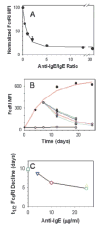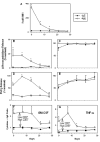Omalizumab reverses the phenotypic and functional effects of IgE-enhanced Fc epsilonRI on human skin mast cells
- PMID: 17617628
- PMCID: PMC2396781
- DOI: 10.4049/jimmunol.179.2.1353
Omalizumab reverses the phenotypic and functional effects of IgE-enhanced Fc epsilonRI on human skin mast cells
Abstract
The dramatic effects of the anti-IgE mAb omalizumab to lower free IgE levels and Fc epsilonRI levels on basophils contrast with more modest clinical effects. Accordingly, whether IgE modulates Fc epsilonRI levels and Fc epsilonRI-dependent mediator release in vitro on human skin mast cells (MC(TC) type) that had matured in vivo is of interest. IgE reversibly enhanced Fc epsilonRI levels on MC(TC) cells in a dose- and time-dependent manner (up-regulation t(1/2) of 4-5 days with 1-3 microg/ml IgE), without affecting cell proliferation. A molar ratio of omalizumab to IgE of 0.9 at baseline prevented receptor up-regulation by 50%, whereas adding omalizumab to MC(TC) cells already with IgE-enhanced Fc epsilonRI levels at molar ratios of 5, 12.5, and 31 reduced Fc epsilonRI levels to baseline with respective t(1/2) values of 8.7, 6.3, and 4.8 days. MC(TC) cells with IgE-enhanced Fc epsilonRI levels were more sensitive to stimulation with a low dose of anti-Fc epsilonRI mAb in terms of degranulation and production of PGD(2), GM-CSF, IL-6, IL-13, and TNF-alpha. Reducing up-regulated Fc epsilonRI levels with omalizumab also reduced mediator release to a low dose of anti-Fc epsilonRI mAb to baseline by 3-4 wk. Thus, reducing free IgE should decrease the hypersensitivity of allergic individuals to low naturally occurring concentrations of allergens.
Figures


 , light blue line). Each data point is the mean of triplicate determinations. C, Relationship of the t1/2 for the decline in IgE-enhanced FcεRI MFI to the amount of anti-IgE. Data from B were used to calculate t1/2 values. Symbols are the same as in B, and symbol colors correspond to the line colors in B.
, light blue line). Each data point is the mean of triplicate determinations. C, Relationship of the t1/2 for the decline in IgE-enhanced FcεRI MFI to the amount of anti-IgE. Data from B were used to calculate t1/2 values. Symbols are the same as in B, and symbol colors correspond to the line colors in B.



Similar articles
-
Inhibition of human cord blood-derived mast cell responses by anti-Fc epsilon RI mAb 15/1 versus anti-IgE Omalizumab.Immunol Lett. 2007 Apr 15;109(2):120-8. doi: 10.1016/j.imlet.2007.02.003. Epub 2007 Mar 1. Immunol Lett. 2007. PMID: 17368811
-
The immunoglobulin E receptor: expression and regulation.Curr Allergy Asthma Rep. 2005 May;5(3):191-6. doi: 10.1007/s11882-005-0037-5. Curr Allergy Asthma Rep. 2005. PMID: 15842956 Review.
-
Selinidin suppresses IgE-mediated mast cell activation by inhibiting multiple steps of Fc epsilonRI signaling.Biol Pharm Bull. 2008 Mar;31(3):442-8. doi: 10.1248/bpb.31.442. Biol Pharm Bull. 2008. PMID: 18310907
-
The anti-inflammatory effects of omalizumab confirm the central role of IgE in allergic inflammation.J Allergy Clin Immunol. 2005 Mar;115(3):459-65. doi: 10.1016/j.jaci.2004.11.053. J Allergy Clin Immunol. 2005. PMID: 15753888 Review.
-
An anti-IgE monoclonal antibody that binds to IgE on CD23 but not on high-affinity IgE.Fc receptors.Immunobiology. 2012 Jul;217(7):676-83. doi: 10.1016/j.imbio.2011.11.006. Epub 2011 Nov 25. Immunobiology. 2012. PMID: 22226669
Cited by
-
GSK2646264, a spleen tyrosine kinase inhibitor, attenuates the release of histamine in ex vivo human skin.Br J Pharmacol. 2019 Apr;176(8):1135-1142. doi: 10.1111/bph.14610. Epub 2019 Mar 21. Br J Pharmacol. 2019. PMID: 30735243 Free PMC article.
-
IgE, mast cells, basophils, and eosinophils.J Allergy Clin Immunol. 2010 Feb;125(2 Suppl 2):S73-80. doi: 10.1016/j.jaci.2009.11.017. J Allergy Clin Immunol. 2010. PMID: 20176269 Free PMC article. Review.
-
Omalizumab therapy in three patients with chronic autoimmune urticaria.Ann Saudi Med. 2010 Nov-Dec;30(6):478-81. doi: 10.4103/0256-4947.70567. Ann Saudi Med. 2010. PMID: 20864790 Free PMC article.
-
Dependence of Optimal Histamine Release on Cell Surface IgE Density on Human Basophils: Nature of the Stimulus.Int Arch Allergy Immunol. 2018;177(3):181-191. doi: 10.1159/000490152. Epub 2018 Aug 27. Int Arch Allergy Immunol. 2018. PMID: 30149387 Free PMC article.
-
Allergen Valency, Dose, and FcεRI Occupancy Set Thresholds for Secretory Responses to Pen a 1 and Motivate Design of Hypoallergens.J Immunol. 2017 Feb 1;198(3):1034-1046. doi: 10.4049/jimmunol.1601334. Epub 2016 Dec 30. J Immunol. 2017. PMID: 28039304 Free PMC article.
References
-
- Asai K, Kitaura J, Kawakami Y, Yamagata N, Tsai M, Carbone DP, Liu FT, Galli SJ, Kawakami T. Regulation of mast cell survival by IgE. Immunity. 2001;14:791–800. - PubMed
-
- Kawakami T, Galli SJ. Regulation of mast-cell and basophil function and survival by IgE. Nat Rev Immunol. 2002;2:773–786. - PubMed
-
- Kitaura J, Song J, Tsai M, Asai K, Maeda-Yamamoto M, Mocsai A, Kawakami Y, Liu FT, Lowell CA, Barisas BG, et al. Evidence that IgE molecules mediate a spectrum of effects on mast cell survival and activation via aggregation of the FcepsilonRI. Proc Natl Acad Sci USA. 2003;100:12911–12916. - PMC - PubMed
-
- Lantz CS, Yamaguchi M, Oettgen HC, Katona IM, Miyajima I, Kinet JP, Galli SJ. IgE regulates mouse basophil FcεRI expression in vivo. J Immunol. 1997;158:2517–2521. - PubMed
Publication types
MeSH terms
Substances
Grants and funding
LinkOut - more resources
Full Text Sources
Miscellaneous

